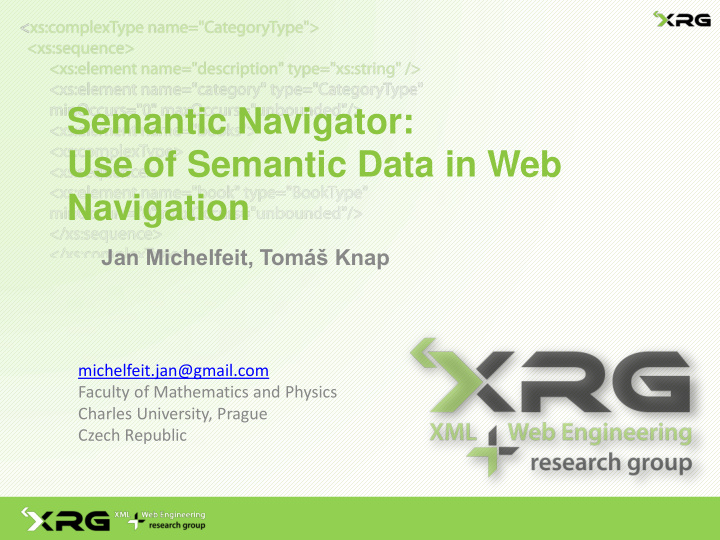



Semantic Navigator: Use of Semantic Data in Web Navigation Jan Michelfeit, Tomáš Knap michelfeit.jan@gmail.com Faculty of Mathematics and Physics Charles University, Prague Czech Republic
emantic Navigator Tool for navigation on the web of documents Mozilla Firefox extension Supports a familiar paradigm of searching for information in web documents Solves some of the issues with traditional web search using a Semantic Web search engine Charles University in Prague 2
Problems with traditional web search Search term ambiguity The film "Casino"? A Las Vegas Casino? Online Casino? No support for search of property values Search for "Casino release year"? "Casino produced"? " Casino released "? "Casino opening weekend"? 3
Problems with browsing LD Ordinary users are not used to it Extra effort to validate provenance Estabilishing trust to the data source http://www.w3.org/TR/rdf-primer/ 4
We‘ve got a solution Use semantic data for web search Suggest properties from ontologies Provide quick access the search without leaving your browser Adhere to the traditional paradigm locate documents – find information manually 5
Goals of Semantic Navigator Make web navigation easier in discovering more information about a selected entity more information about its properties Take advantage of technologies such as RDF(a), microformats or ontologies Bring advantages of the Semantic Web search to ordinary users Be versatile, not domain specific 6
How to use it Highlight resources What you search for Search results Charles University in Prague 7
An Example Navigate to www.wikier.org 1 Presence of RDFa is detected 1 Homepage of Sergio Fernández, used with his kind permission 8
An Example Highlight semantic data with Semantic Navigator 9
An Example We want to know more about people that Sergio knows → Click on the resource and select foaf:knows in the menu 10
An Example We want to know more about people that Sergio knows → Click on the resource and select foaf:knows in the menu 11
An Example Get suggested people, search for more documents about them 12
More examples semantic-navigator-screencast.avi 13
Internals Mozilla Firefox extension Uses a Java component (Any23, Jena libraries) Gets search results from Sindice Provides suggestions for triple subjects/objects retrieved from Sindice SPARQL endpoint Provides direct access to summaries on Sig.ma 14
Internals architecture outline 15
Internals step by step 1) Detect semantic data RDFa, microformats, RDF documents linked by a <link> element • 2) Extract data and create an RDF graph 3) Optionally import used ontologies (cached) 4) Optionally highlight data in the web page includes detection of literal occurences in non-annotated text 5) The users selects what she is interested in 6) Display search results retrieved from Sindice 16
Future work what we can improve Usability for non-technical users Drop dependency on Java Deal with insufficient identifier sharing Filter by xml:lang for literals More sophisticated search - use IFPs, owl:sameAs links, search by blank nodes Filtering and suggestions of properties while typing Searching for a manually entered keyword 17
Future work What the world can do for us Publish data in RDFa, microformats etc. or link to an RDF alternative from HTML Share identifiers, use owl:sameAs links Continue the great work on Semantic Web search engines 18
Possible future applications More general alternative to domain-specific solutions Effortless Wikipedia-like Navigation 19
Thank you for your attention Jan Michelfeit, Tomáš Knap michelfeit.jan@gmail.com Faculty of Mathematics and Physics Charles University, Prague Czech Republic
Recommend
More recommend